Customer retention through increased customer loyalty is key to increased profitability since acquiring new customers is more expensive than keeping current ones. The obvious question is: how can this loyalty be attained. Customer loyalty is taxed most when a customer has a complaint. However, a problem is also an opportunity. Research (see references below) has shown that customers who have had a problem resolved effectively through a company’s service recovery actions are in fact more loyal than those who have not had a problem. So, a customer complaint is a bad news/good news situation. However, another caveat: poor handling of a customer issue will just further exacerbate customer dissatisfaction.
Service recovery is more than complaint handling. It is recovering a customer’s positive feelings about a company after a bad experience and taking action to resolve the root cause of the problem. Complaint handling connotes just addressing the negative. Service recovery means turning the issue into a positive — both for the customer and for the company through the learning opportunity.
I like to explore companies’ service recovery practices in my own economic transactions, and I’m always asking about others’ experiences. Awhile ago I received an inquiry about service recovery practices from Chris Gibbs, the Director of Client Services for the Toronto Maple Leafs Sports and Entertainment. “Service recovery in a sports franchise?” was the thought that hit me. My background — aside from my university teaching — is after-sales support services for technical products, and that industry has been my focus for customer satisfaction and loyalty work. However, web searches and keyword advertising has led to a broadened focus for my Survey Design Workshops, since the ads have garnered inquiries across industries and across organizational functions.
So, this opportunity to examine service recovery practices in another industry — particularly the sports industry — piqued my interest. What service recovery lessons could a sports franchise provide? Intrigued, I took the opportunity presented by a trip to Toronto to visit with Chris. Earlier this year, I also the chance to hear Pete Winemiller, VP of Service Development for the Seattle SuperSonics and Seattle Storm speak at the Customer Care Institute’s conference. The two organizations share approaches, but with some difference in application.
Toronto Maple Leafs Sports and Entertainment presents both hockey — the Maple Leafs — and basketball — the Raptors — as well as concerts and other events that use the Air Canada Centre, which it owns and operates. Gibbs’ focus is on the fan experience. His goal is to make the game or event an enjoyable experience (even if the home team loses). The stadium should not be a distraction, but should be a positive part of the experience. They must meet the fans’ “basic expectations” — a clean building, fast food service, and friendly staff — but hopefully move beyond that to create “delighted” customers who will “spread the good word about our building and sports teams.” Equally importantly, they want to avoid “fan outrage” that may result when the fan feels he has been treated unfairly or have his personal security violated.
Similarly, the SuperSonics CEO Howard Schultz says, “We want to the most fan-centric organization in professional sports.” Not first class or world class, but “world famous” according to Winemiller Schultz stresses to his staff that they are not in the basketball business, but in the people business. “Companies don’t ‘make’ money; they get it from their customers.” Winemiller’s team focuses on the “driveway to driveway experience” and to give fans “magic moments [not] tragic moments.”
Service Recovery in a Sports Franchise
But how does service recovery come into play with a sports team? Fans can have problems, anything from a spilled drink to a noisy obnoxious neighbor, a bad view or a more involved problem. Gibbs has three rules for handling recover situations: “recover quickly, recover effectively, and improve the situation.” To accomplish this, he has three levels of handling customer issues at the Air Canada Centre.
- Front line employees. Employees, the ushers, are empowered to handle a problem in their area. In essence, they own customer satisfaction in their section of the stadium. You might think that if a fan spills a drink or a child drops her hot dog, tough luck. Make them buy another. More business! (That was my expectation based on childhood memories at Fenway Park.) Instead, the ushers will get a replacement food item for the patron and get the mess cleaned up. In Gibb’s mind, this is an inexpensive opportunity to buy considerable fan goodwill and create “fan delight.” An usher may also arrange for a father and son who have tickets in the nose-bleed sections to sit in the lower boxes during practice. It’s these “little things that make the difference.”When dealing with the irate fan, Gibbs wants his employees to be skillful in defusing the issue by a) explaining the rationale behind any policies, not just hiding behind the blanket statement, b) by being flexible in implementing policies where logical, such as allowing a parent to bring food and juice for an infant, c) showing concern and empathy.
- Customer Service. Some problems require the action of the Centre’s customer service department, for example, if someone has a bad sight line at a concert at the Centre or that rather effusive (and possibly abusive) neighbor. Customer Service will relocate the person as best as possible, sometimes using the wheelchair locations that create some seating buffer. Once, a customer accidentally ripped his pants, splitting a seam. They got the fan into a back room and mended the pants. (I’m sure there was a TV in the waiting room so no action was missed.)
- Senior Staff. Some problems require decisions at Gibbs’ level. For example, at a Julio Iglesias concert, they received a huge number of complaints from one section due to the sound quality. The whole section was granted complimentary tickets for the next Iglesias concert in Toronto. Then there were the three guys from Israel who traveled all the way to Toronto to see the Raptors, but missed the game because they miscalculated the time zone change. Gibbs’ group played travel agent for the fans, changing their airplane tickets, getting them a cheap hotel, and giving them tickets to the next Raptors home game.For the SuperSonics, there is a similar emphasis on the front line for problem resolution. Since “70% of customers will provide repeat business if a problem is resolved eventually, but 95% will do business again if the problem is resolved on the spot,” the employees “have the green light to make your guest experience gold… The front line is the bottom-line all the time.”In fact, the SuperSonics don’t refer to the fans as customers, but rather as “guests” because of the connotations that word brings to how they should be treated. Winemiller pointed out that the second definition of “customer” in the American Heritage dictionary is “An individual with whom one must deal: a tough customer.” In fact, the SuperSonics don’t have a Customer Service department; rather, they have a Guest Care department.
This all reminds me of an article written many years ago by Tom Petzinger for his The Front Lines column in the Wall Street Journal, The Beer Man at Camden Yards. This beer vendor was a cut above all others. (At Camden Yards beer is served in the stands by vendors.) He had devised equipment that allowed him to pour beer twice as a fast. He knew all the season ticket holders in his sections and would greet people who came on borrowed tickets. What particularly astonished Tom was that he even chatted with the fans who didn’t drink beer. Everyone was his customer since all the fans contributed to each others’ enjoyment of the game. Amazingly, he didn’t collect money when he served. Instead, he’s come back in the late innings after beer serving had ended and collected. He trusted his patrons — and they were probably looser with tips at that point. Talk about an empowered employee taking ownership of customer satisfaction!
The Critical Role of Employees
Following the lessons of the Service Profit Chain, Gibbs quite openly states that the key to his success lies in his people. His goal is to get employees to own the fan experience. Tactically, his goal is to grow the number of employees who think this way and to practice the 3 Fs: Find, Fix, and Follow-up. But employee behaviors and practices don’t turn on a dime. Old ways die hard, especially when in a union environment.
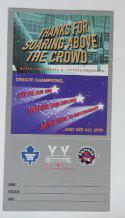 Gibbs has approached this challenge by winning over employees one at a time by showing the impact that good practices can have. Employees have a website where their work schedule is posted. This provides a mechanism for putting the positive points before the employees’ eyes on a regular basis. They have plaques on the wall with thank you letters from fans. Chris focuses on so-called “teachable points of view” (TOVs). TOVs are particularly difficult to instill in part-time employees who don’t have a long-term bond to the organization. Teaching through example is the approach that has worked best.
Gibbs has approached this challenge by winning over employees one at a time by showing the impact that good practices can have. Employees have a website where their work schedule is posted. This provides a mechanism for putting the positive points before the employees’ eyes on a regular basis. They have plaques on the wall with thank you letters from fans. Chris focuses on so-called “teachable points of view” (TOVs). TOVs are particularly difficult to instill in part-time employees who don’t have a long-term bond to the organization. Teaching through example is the approach that has worked best.
Gibbs also employ “mystery shoppers” who report on their experiences as a customer. To keep the cost of this research reasonable, they recruit customers and have employees to do the reporting. Mystery shoppers use a 70-question feedback form with coverage in 10 critical measurement areas. Interestingly, they don’t use the results as a club against bad employees. Instead, they publicly reward those employees who got a 100% rating, and privately communicate with those employees who didn’t receive the full score. This keeps the cultural message positive. They want to “catch people doing things right, not just doing things wrong.” According to Gibbs, “Measure what you need. Reward what you want repeated.” They also use this and other feedback “to learn from our failures or successes.”
For the SuperSonics, their challenges are perhaps greater since almost all of the 500-person staff at Key Arena works for the Arena and not for the SuperSonics, which rents the Arena. Their goal is to change employees’ “attitude of indifference… [to an] attitude of invitation” since “business goes where it’s invited but stays where it’s appreciated.” They have “Think Big” ideas that prompt “Act Small” actions for the employees. RAVE is their motto which is “Respect And Value Everyone.” Plus they want their employees to CLICK with their guests.
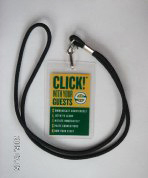 Communicate courteously.
Communicate courteously.
Listen to learn — learn from every question a guest asks.
Initiate immediately — deliver fast, waits just make the situation worse.
Create connections — connect with your guests.
Know your stuff — product knowledge, e.g., cost of concessions and ATM locations
The goal is to become CLICK certified: Winemiller also cited a UCLA study on how we communicate. The actual words only represented 7% of the communicated message. The tone of voice and nonverbal expression delivered most of the message at 38% and 55%, respectively.
His point is that people do what they’re shown to do, not what they’re told, and they work on communicating a totally positive message. Winemiller tells his employees, “It’s not doing one thing 100% better. It’s doing 100 things 1% better.” He asks everyone on this staff what 1 idea would they commit to improving 1% for the next year and to write it on a card with the CLICK logo worn hung from a lanyard. He wears one himself.
Managing the Customer’s Role in the Service Experience
In the classes I teach on service management, we stress that to deliver quality service, a service provider must manage all the different sources of variability, such as the variable arrival pattern of customers, the variable length of service delivery, and the variability that uncertain and unpredictable customers bring to the operation. These are the challenges that set service managers apart from their manufacturing peers.
Perhaps the most difficult variability to manage is the customer-to-customer interaction. Ever been at the movies when someone talks throughout the movie — on a cell phone! — or on a plane where the person in the row in back of you constantly kicks your seat back? Think of the fan-to-fan interactions possible at a sporting event. Fan relocation is common, and the Gibbs’ group at the Air Canada Centre has gotten good at handling this. Why? They’ve learned from their history. Plus, there’s repetition. The same fans — season ticket holders — return again and again.
The real challenge lies with concerts held at the Centre. Each concert is unique to some extent. Sound systems are arranged differently, and you don’t have the same fans seated next to each other repeatedly. So, even with lots of experience, unpredictable problems with seating will demand resolution on an individual basis. They will relocate fans with obstructed view seats on the spot where possible.
The customer’s role in the service experience poses an interesting question for service managers who must handle service recovery. Is the customer always right? Gibbs feels that for tangible products, the customer is always right assuming they did their due diligence to learn what they bought. But with services, the customer’s role in the service experience has to be added to the calculus. The customer is not always right. So they have a debate about when the customer is owed an apology and when he is not.
Service Recovery Outcomes
What’s the result of their service recovery practices? The Maple Leafs have a 97% season ticket renewal rate. The Maple Leafs are a Toronto — a Canadian – institution, so the fan loyalty would be high. But loyalty can change quickly. In my home town, Boston, the Bruins were perennial sell outs even when the Celtics had championship teams. Lately, though, attendance has fallen precipitously — and with the strike resolved who knows were attendance will go. A better team would certainly have helped, but would better service recovery practices also have helped? In Toronto the Maple Leafs have the Blue Jays’ experience from which to learn. In the early 1990s, the Blue Jays sold out regularly, but when the team on the field weakened, so did attendance. Did the Blue Jays take their fans for granted? Maybe that’s part of why they recently bought their ball park to better control the fan experience.
The Maple Leafs want to be sure their fans don’t feel taken for granted. Each year tickets for seasons ticket holders are delivered in some handsome gift set, e.g., in a beautiful wooden box with other Maple Leaf mementos to demonstrate an appreciation for the fans.
Lessons from the Sports World
What lessons can be drawn from these examples of service recovery in a sports environment?
- Positive customer satisfaction is more than the lack of customer dissatisfaction.
- Meeting the basic expectations does not bond customers to an enterprise.
- Service recovery promotes a proactive attitude toward improving customer satisfaction.
- The key tenets of service recovery: Listen, Resolve, Compensate, and Learn.
- Empowered employees — who want to use their empowerment — are key to a service recovery program.
- The culture must be ready for service recovery since employees must own it and drive it.
- Leadership – and leading by example — is critical to establishing the proper culture.
Service recovery, while typically funded from an operational budget, is really a marketing program. This type of program can deliver a very high ROI through its effects on customer retention.
Articles on Service Recovery
Here are useful articles and links on service recovery:
- “The Profitable Art of Service Recovery,” Christopher W.L. Hart, James L. Heskett, W. Earl Sasser, Jr., Harvard Business Review, 1990, Reprint #90407. (also available from Amazon)
- “Recovering and Learning from Service Behavior,” Stephen S. Tax & Stephen W. Brown, MIT Sloan Management Review, Fall 1998, pp 75-88, Reprint 4016.
- “Putting the Service Chain to Work,” James Heskett & Thomas O. Jones, Harvard Business Review, March/April 1994, vol 72.
- The Service Profit Chain, James L. Heskett, W. Earl Sasser, Leonard A. Schlesinger, Free Press, 1997.
- The Value Profit Chain, James L. Heskett, W. Earl Sasser, Leonard A. Schlesinger, Free Press, 2003.
- “Understanding Customer Delight and Outrage,” Benjamin Schneider, David E. Bowen, MIT Sloan Management Review, Fall 1999, pp 75-88.
- Knock Your Socks Off Service Recovery, Ron Zemke, Chip R. Bell, AMA
- Delivering Knock Your Socks Off Service, Kristin Anderson, Ron Zemke, AMA, 1998.
Also, a couple of vendors have software applications that help manage the complaint handling process to effect positive service recovery.

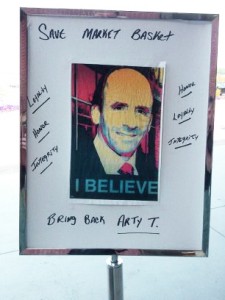 I live in a state — Massachusetts — known for its quirks. And right now we have a really quirky event transpiring. A local company’s employees are on strike because of the CEO. What’s odd about that? They’re striking (or boycotting) in support of a fired CEO. And they’re not union employees, so they could all be fired today with little or no legal recourse.
I live in a state — Massachusetts — known for its quirks. And right now we have a really quirky event transpiring. A local company’s employees are on strike because of the CEO. What’s odd about that? They’re striking (or boycotting) in support of a fired CEO. And they’re not union employees, so they could all be fired today with little or no legal recourse.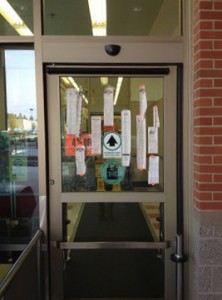 Of course, maybe Arty’s approach is the real profit maximizing one. Maybe his lower margins have created a hugely loyal customer base, leading to greater volume, and maybe his employee practices mean that customers get a more positive experience, garnering greater loyalty. I recently wrote about a similar story at
Of course, maybe Arty’s approach is the real profit maximizing one. Maybe his lower margins have created a hugely loyal customer base, leading to greater volume, and maybe his employee practices mean that customers get a more positive experience, garnering greater loyalty. I recently wrote about a similar story at 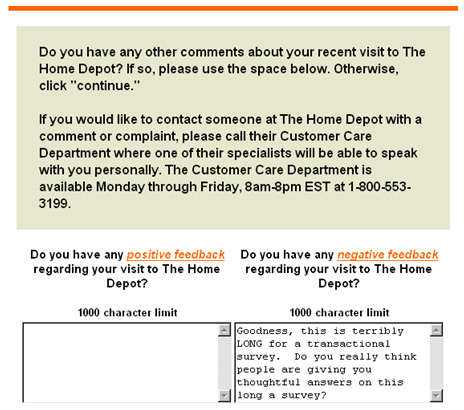

 Gibbs has approached this challenge by winning over employees one at a time by showing the impact that good practices can have. Employees have a website where their work schedule is posted. This provides a mechanism for putting the positive points before the employees’ eyes on a regular basis. They have plaques on the wall with thank you letters from fans. Chris focuses on so-called “
Gibbs has approached this challenge by winning over employees one at a time by showing the impact that good practices can have. Employees have a website where their work schedule is posted. This provides a mechanism for putting the positive points before the employees’ eyes on a regular basis. They have plaques on the wall with thank you letters from fans. Chris focuses on so-called “ Communicate courteously.
Communicate courteously.